In the grim darkness of the far future, there is only war. Warhammer 40K is a setting known to many. But its most visible face are grim, bald men in huge pauldrons, mowing down aliens. And that’s certainly a thing that happens there. But I’d like to talk about Dark Heresy. It’s a tabletop role-playing game that lets us experience this setting on a much different scale – in my not-so-humble opinion, a more compelling one.
The Imperium of Man is a sprawling leviathan of an empire. It extends from Holy Terra (that is, Earth) to cover a large expanse of the Milky Way galaxy. It’s made up of countless worlds, with a few lynchpins to connect them. The first and foremost is the faith in the God-Emperor of Mankind. He founded the Imperium and united the scattered human worlds under his rule, but now, he sits half-alive on the Golden Throne. His servants carry out what they think is His will on all the worlds of the Imperium.
The list of various political, administrative and religious authorities in the Imperium is long, and other people have explained them better than I could. What you need to know, dear readers, is that the Imperium of Man is not a nice place. The Emperor wanted it to be an enlightened society of science and reason. Following his entombment on the Golden Throne, it has instead become an oppressive theocracy.
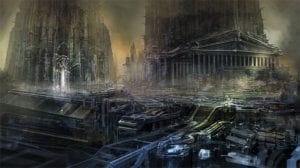
Independent thought is generally considered to be a gateway to heresy and sedition. Fear and superstition surround what technology humanity hasn’t forgotten. The Church preaches ignorance and obedience. The people of the Imperium are adrift in the dark, hostile universe. Only the light of the immortal God-Emperor can protect them – as long as they obey His chosen representatives. Thought begets Heresy; Heresy begets Retribution.
If that sounds bleak… well, it is. But it’s not without justification. Enemies from within and without do surround humanity at all sides. Stalwart Space Marines, zealous Sisters of Battle and innumerable ranks of the Imperial Guard fight tooth and nail to push external enemies back. Other forces watch the teeming masses of humanity for internal ones.
In Dark Heresy, the player characters are part of one of the latter groups. The Emperor’s Holy Inquisition is one of the single most powerful entities in the Imperium. The Inquisitors have a great deal of leeway in rooting out heresy, treason and sedition. If pressed, they can invoke the judgement of Exterminatus, which means completely eradicating all life on a given planet, using large-scale weapons.

“In fealty to the God-Emperor, our undying Lord, and by the grace of the Golden Throne, I declare Exterminatus upon the imperial world of Typhon Primaris. I hereby sign the death warrant of an entire world, and consign a million souls to oblivion. May Imperial Justice account in all balance. The Emperor protects.”
Of course… the players don’t play Inquisitors in Dark Heresy. The play Acolytes. That is to say, the lowest rung of the ladder. They’re the Inquisition’s foot-sloggers and ground-pounders. They go in to investigate and disarm potential threats. They’re not as expendable as most Imperial citizens are… but not terribly important, either.
This is what I mean by a different perspective. Warhammer 40K’s most recognizable face is the wargame. That means a focus on the Space Marines, ever Games Workshop’s favorite, and clashing armies. The Imperium is a backdrop to it. But characters in Dark Heresy move among the folk of the Imperium – by and large, they are folk of the Imperium. So we get to see what life is like on the ground level of a galaxy-spanning theocracy forever teetering on the brink of chaos.
Of course, there’s no such thing as a “typical” Imperial world, or Imperial citizen. The God-Emperor’s domain spans countless planets. The setting described in Dark Heresy book encompasses one sector – the Calixis sector in its first edition, and the Askellon sector in the second one, which I’m talking about here. Even a single sector contains any type of worlds you can imagine, however.
This sheer variety is something that might be a bit hard to grasp for a newcomer to Warhammer 40k. I know it was for me. The kind of environment that comes to mind most readily is a crowded hive-city of a planet-wide megalopolis. That is, indeed, what many worlds will look like. But there are also feudal worlds, with society and technology reminiscent of Earth history. Death worlds, which… well, just like it says on the tin: hellscapes where survival is a daily battle. Forge Worlds, which serve Adeptus Mechanicus, a cult controlling the Imperium’s scientific and engineering knowledge, as factories, mines and manufacturing plants. And many more.
The basic structure the players belong to is an “Acolyte Cell”. This means simply a group of acolytes organized by an 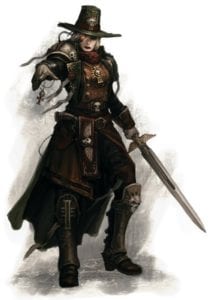 Inquisitor and sent into the field. The acolytes’ recruitment varies. Some join willingly. Some have no choice. Many are essentially pressed into service. Inquisitors wield considerable power, so they can recruit outright criminals, if they so choose.
Inquisitor and sent into the field. The acolytes’ recruitment varies. Some join willingly. Some have no choice. Many are essentially pressed into service. Inquisitors wield considerable power, so they can recruit outright criminals, if they so choose.
Of course, said criminal must present some sort of worth to the Inquisitor. That means the general assumption behind character creation is that everyone in a cell did stand out enough for an Inquisitor to take notice. Willingly or not, do not ask why you serve – only ask how.
The player needs to decide three things when they start making their character – a homeworld, a background and a role. The first is rather obvious – you decide which type of world your character comes from. Background means the Imperial institution or group your character belonged to before joining the Inquisition – unless, of course, they’re a criminal or someone similar. The role is the most abstract part, since it nails down the character’s main skills and aptitudes. Roles include warriors, seekers (detectives), sages, assassins and so on.
This three-step process ensures that many different combinations are possible. The nature of the setting means that there’s very little you can’t justify, even if you were to pick each of the three steps at random, which my GM and I actually did, as a thought exercise. Let’s take a look at some randomly-generated combinations, shall we? I will use the opportunity to talk about those character options.
First, I rolled Feudal World, Adeptus Astra Telepathica and Ace – homeworld, background and role, in order. Feudal worlds, like I mentioned above, are planets where civilization has a pre-industrial level. They also exhibit stratified, rigid social hierarchies, even more so than the rest of the Imperium. Adeptus Astra Telepathica is an Imperial institution whose task is to control, regulation and training of people with psychic power. Ace is a role focusing on using vehicles and mounts. An unusual combination, but very much workable. The Ace role might look like it conflicts with a feudal world, lacking as they are in vehicles. The solutions to this are either beasts of burden, or the Imperium’s often strange levels of technology. From there it’s just a matter of determining how such a person came to the Inquisition.
The second result came out as Penal Colony, Adeptus Arbites and Chirurgeon. Penal colonies are just what they sound like – prison planets. Awful places by any standards, where the Imperium rounds up undesirables. Adeptus Arbites are an Imperium-wide law enforcement agency. They rank higher than the local lawmen, and concern themselves with serious crimes like treason and sedition. Chirurgeons are, unsurprisingly, a role specializing in medicine and related sciences. Those three options are easy to reconcile; Adeptus Arbites would have a presence on a penal colony, and they will certainly need doctors there.
My third rolls resulted in Garden World, Adeptus Mechanicus and Hierophant. Garden worlds are 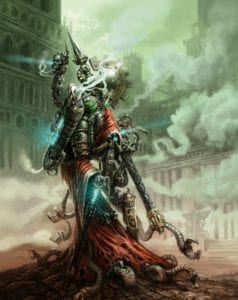 uncharacteristically peaceful and serene spots in the bleak landscape of Warhammer 40K’s galaxy. They’re largely untouched by technology and industry, and populated by small communities – often monasteries or hospitals. Adeptus Mechanicus is the group that holds sway over the Imperium’s technology. They worship the Emperor as the Omnissiah, the Machine-God. As you can expect, they’re powerful and influential – almost an empire within an empire. They treat technology with religious reverence, and are eager to replace their bodies with cybernetic enhancements. Hierophants specialize in leadership, command and oratory skills. They lead people into battle or sway them with words.
uncharacteristically peaceful and serene spots in the bleak landscape of Warhammer 40K’s galaxy. They’re largely untouched by technology and industry, and populated by small communities – often monasteries or hospitals. Adeptus Mechanicus is the group that holds sway over the Imperium’s technology. They worship the Emperor as the Omnissiah, the Machine-God. As you can expect, they’re powerful and influential – almost an empire within an empire. They treat technology with religious reverence, and are eager to replace their bodies with cybernetic enhancements. Hierophants specialize in leadership, command and oratory skills. They lead people into battle or sway them with words.
The major point of disassociation this set is that a garden world is an odd place for a machine-cultist. But garden worlds still need technology, which the Adeptus Mechanicus administer. And they have agents everywhere. A character with those three options would likely be an ambassador of the Machine Cult on a garden world, whose cybernetic enhancement are less overt and who hides their cold, calculating mind behind diplomacy.
I mentioned psychics earlier, and they deserve an elaboration. In Dark Heresy and the setting as a whole, calls them “psykers”. They’re humans born with a connection to the Warp, which is a realm of souls and thoughts – and daemons. This gives them supernatural powers, but also renders them vulnerable to daemonic possession. Psykers in the Imperium of Man are charges of Adeptus Astra Telepathica, and serve two roles.
Those strong enough undergo rigorous training that gives them the title of “sanctioned” psykers. They then serve in 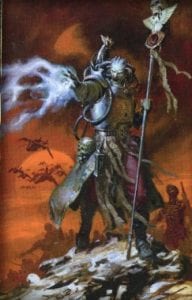 various Imperial institutions – such as the Inquisition, of course. Those who don’t clear this bar are indoctrinated and sent to Holy Terra. There, their souls are sacrificed by the thousands to maintain the God-Emperor’s undeath, and keep the Golden Throne functioning. When we say the setting is grimdark, we mean it.
various Imperial institutions – such as the Inquisition, of course. Those who don’t clear this bar are indoctrinated and sent to Holy Terra. There, their souls are sacrificed by the thousands to maintain the God-Emperor’s undeath, and keep the Golden Throne functioning. When we say the setting is grimdark, we mean it.
A starting character can be a psyker if they choose a particular role – Mystic. Then they have a choice. If they choose Adeptus Astra Telepathica as their background, it means they’re properly sanctioned. Otherwise, they’re rogue psykers. They use their powers outside Imperial jurisdiction. Not every Inquisitor is willing to work with one of those – some scoff at using sanctioned psykers. Being a rogue psyker is one of the worst things you can do in the Imperium, so such a character needs to be quite cautious.
You may be asking, “what does a game of Dark Heresy actually look like?” The answer is as varied as the people who play this system, but there are some common threads.
First off: Dark Heresy is an investigative game by nature. The Inquisition’s job is to root out less than obvious threats to humanity – those that come openly are for other forces to deal with. Players will inevitably spend a lot of time digging up secrets, searching for clues and uncovering truths. This presents a unique challenge for the game master, who will sometimes (or often) face the conundrum of players running up a wall or charging off on a tangent.
The second layer is social interaction. There are foes of humanity who hide entirely beyond it and never interact with it. But most of the enemies the acolytes will hunt down hide within it. Chaos cultists, hereteks (yes, pursuing technological innovation is a heretical activity), seditionists… they need to feed off society to operate. And so, the acolytes need to mingle in order to find them.
That’s not all they need from people, though. The Inquisition is an incredibly powerful organization, but the acolytes are its bottom rung. They can’t rely on its authority – not to mention that throwing their weight around would cause their quarry to go to ground immediately. So they need to cooperate with law enforcements, influential groups, even criminals. They need contacts and support. Our game master places a lot of emphasis on it. Not that I complain, given how I play the party’s social specialist (and only sane member who isn’t an antisocial gearhead).
As the acolytes need to wheel-and-deal their way through intrigues and opposing interests, they will have to make compromises. For all that they may believe that compromise is akin to treachery, they can’t just stomp their way to their target. Sometimes, a lesser threat or heresy must be suffered to exist, so that the greater goal is accomplished.
For all the plots, uncovering thereof and social maneuvering, eventually things get hot. Which gets us to combat. The setting being what it is, it’s pretty inevitable. And dangerous. Characters in Dark Heresy are very much human, and being on the receiving end of bullets, laser bolts and chainswords (hose are exactly what they sound like) is lethal. As such, cover and positioning are very important. Stay in cover, fight smart, and use suppression fire and grenades.
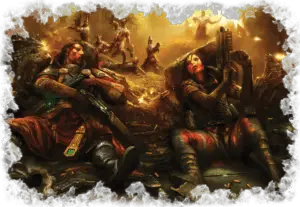
Death is a very real possibility in the grim reality of the 41st millennium. The Martyr’s grave is the foundation of the Imperium, but it’s still not very fun to the player if their character dies from a lucky shot. Fate points come to their aid here. Every character has a pool of fate points, usually two or three at the beginning. You can spend them to aid your rolls in various ways, and everyone regains them at the end of a game session.
However, if the character faces mortal danger, fate points can be burnt instead. A fate point used this way is lost forever, but a character manages to survive something that should have killed them. One could call it luck, or the will of the Emperor. The game master can award players fate points for daring plans or resounding successes, so it’s possible to earn them back.
Having said that, I’ll leave you with one, final warning, should you play Dark Heresy – beware of psykers. A psychic character can become very, very powerful. In our game, the party psyker has firepower to qualify her as a piece of artillery, and she also learned to read and control minds. Using psyker powers invites perils of the Warp, but those can are surprisingly easy to mitigate. And I’ve heard it was even worse in the first edition. Go figure. So, keep that in mind.
So, this is it. I hope I presented a side of the Warhammer 40K setting you hadn’t seen before, and sparked an interest in playing Dark Heresy, or perhaps another game set in that universe. Go with the Emperor, and remember – only in death does duty end.
Images courtesy of Games Workshop.

